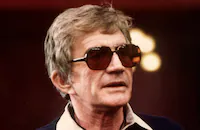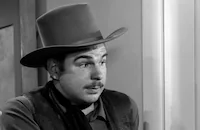Wing and a Prayer
Brief Synopsis
Cast & Crew
Henry Hathaway
Don Ameche
Dana Andrews
William Eythe
Charles Bickford
Sir Cedric Hardwicke
Film Details
Technical Specs

Synopsis
Three months after the Japanese attack on Pearl Harbor, American citizens wonder why the U.S. Navy has not yet retaliated. Navy officials, hoping to lure the Japanese Navy into a trap, decide to send one carrier on a decoy mission while assembling the majority of U.S. forces at Midway. The ship chosen, Carrier X, receives orders to sail the Pacific and not engage the enemy, on the water or in the air, in order to lull the Japanese into a false sense of security. Carrier X's captain, Waddell, and air officer, Cmdr. "Bingo" Harper, watch as Lt. Cmdr. Edward Moulton of Torpedo Squadron 5 flies in with his pilots: Ensigns Malcolm Brainard, Gus Chisholm, "Lovebug" Markham, Hans Jacobson, Chuck White, Paducah Holloway and Hallam Scott, a film actor who has been nicknamed "Oscar" because of his Academy Award, which he carries as a good luck charm. Harper is infuriated by Scott's sloppy landing and wastes no time reprimanding him. The men are then dismissed, and after settling into their quarters, meet Ensign Charles "Cookie" Cunningham, who recently received the Navy Cross for shooting down three Japanese planes. Cunningham, who is still on the injured list, shyly receives the new men's praise and answers their queries about combat. Scott, meanwhile, is teased about his fan mail and questioned about his screen kisses with Betty Grable. Later, Scott's radioman, Benny O'Neill, discusses Harper with gunner "Beezy" Bessemer, who is afraid that the tough commander will discover that he is only sixteen years old. O'Neill promises to watch over the youngster, and time passes until one day, during a bombing maneuver, Brainard drops a bomb on the target against orders, and Harper orders Moulton to get his men in shape or ship out. As the days go by, the men become frustrated by their orders not to engage the enemy, while Cunningham, who has been certified to return to active duty, grows increasingly nervous. During his first run against attacking Japanese aircraft, the terrified Cunningham crashes his plane into the ocean, and although he and his crew survive, Harper forbids him to fly again. Other pilots and crew members are killed during the attack and subsequent encounters, and the men grow bitter about their orders to stand down. Although Scott's roommate, Chisholm, is killed, the actor continues his egotistical, immature behavior, until Moulton warns him that there are no stars on a carrier, only team players. Finally, Capt. Waddell receives orders to reveal the Navy's strategy with the men, who are thrilled to hear that they are to join the main force at Midway. A dangerous battle awaits them at Midway, and as it will have to be won mostly in the air, the men grimly prepare. At Midway, Carrier X's crew anxiously listen to the radio reports as the pilots engage the Japanese in fierce dogfights. Jacobson and his crew are shot down, and Scott and Beezy hit a Japanese ship, while Benny is killed. A Japanese submarine targets Carrier X with a torpedo, but before the weapon can destroy the ship, Cunningham goes up in a catapult bomber plane and dives into the ocean to intercept the torpedo. Grateful for Cunningham's sacrifice, the sailors work hard to repair the carrier's disabled flight deck. After the battle, a rainstorm begins, and the cloudy conditions prevent Scott and Beezy from locating the carrier. Due to the presence of the remaining enemy, Scott cannot risk establishing radio contact, and although Carrier X's crew can hear Scott's plane as it runs out of gas and falls into the ocean, there is nothing they can do to help. The enraged men confront Harper, who prohibited any radio contact with Scott, and Harper tells them that he is tough on them because he is responsible for them, and that he could not allow Scott to endanger the ship. Just then, Harper receives word that a U.S. destroyer has picked up Scott and Beezy, who turned seventeen that day, and as he goes to post the next day's orders, Harper expresses his happiness at the men's rescue.

Director

Henry Hathaway
Cast

Don Ameche

Dana Andrews

William Eythe

Charles Bickford

Sir Cedric Hardwicke
Kevin O'shea
Richard Jaeckel

Henry Morgan
Richard Crane
Glenn Langan
Renny Mcevoy
Robert Bailey
Reed Hadley
George Mathews
B. S. Pully
Dave Willock
Murray Alper
Charles Lang

Irving Bacon
John Miles
Joseph Haworth
Charles B. Smith

Ray Teal
Charles Trowbridge
John Kelly
Larry Thompson
Billy Lechner
Jerry Shane
Robert Condon
Frank Perry
William Manning
Mel Schubert
Mike Killian
Josh Hardin
Melvin Nix
Louis Hart

Blake Edwards
John Forrest
John Heath
Richard Graham
Rim Conrad
Charles Murray Jr.
Danny Desmond
Tom Cowan
Ted Jordan
Stanley Dunn
Terry Mason
Don Hayden
Ralph Brooke
Gary Bruce
Raymond Roe
Carl Knowles
John Kellogg
Gene Meredith
James Drum
Neil Carter
Tom Holland
Robert Wright
Harry Carter

Eddie Acuff
Eddie Friedman
Frank Marlowe

Ray Walker
George Chandler
Jr. George Offerman
Sidney Miller
George Riley
Wally Scott
Blanche Webb
Harold Schlickenmayer
Michael Owen

Matt Willis
Warren Burr
Terry Ray
Chet Brandenburg
Jimmy Dodd
Robin Short
Jay Ward
Arthur Space
Don Forbes

Pierre Watkin

Edward Van Sloan
Charles Waldron
Frederic Worlock
Frank Mcclure
Selmer Jackson

Jack Mower
Crane Whitley
Albert Van Antwerp
Stanley Andrews
Harry Strang
William Colby
Crew
William A. Bacher
James Bland
Mortimer Braus
Alfred Bruzlin
Jerome Cady
Lewis Creber
Raymond B. Egan
Hugo W. Friedhofer
Roger Heman
R. A. Klune
Thomas Little
Glen Macwilliams
Lt. Cmdr. R. L. Middleton
Walter Morosco
Emil Newman
Guy Pearce
Fred J. Rode
Fred Sersen
Jo Swerling
J. Watson Webb
Henry Weinberger
Lyle Wheeler
Richard A. Whiting

Film Details
Technical Specs

Award Nominations
Best Writing, Screenplay
Quotes
Trivia
Notes
The working titles of this film were Queen of the Flat Tops and Torpedo Squadron 8. The film's onscreen subtitle is The Story of Carrier X. Although the popular aviator slogan "coming in on a wing and a prayer" May have inspired the film's title, the picture is not related to the well-known 1943 song "Comin' In on a Wing and a Prayer," which was written by Harold Adamson and Jimmy McHugh. Following the opening credits, a written prologue reads, "For purposes of military security the names of men and some of the ships in this motion picture are fictitious, but the important incidents and the heroism are history." In the film, the sailors watch a brief clip of Alice Faye, Betty Grable and Billy Gilbert performing "The Sheik of Araby," from the 1940 Twentieth Century-Fox picture Tin Pan Alley.
According to contemporary news items and information in the Twentieth Century-Fox Produced Scripts Collection and Records of the Legal Department, located at the UCLA Arts-Special Collections Library, the studio initially intended the film to be a more biographical and historically factual account of the Battle of Midway, featuring the renowned Topedo Squadron 8 and Ensign George Gay. During the actual battle, all of the fliers in the squadron except Gay were killed as they defended U.S. ships against attacking Japanese planes. According to a September 23, 1942 Hollywood Reporter news item, "The Navy has relented in its stand against the use of the names of war heroes in film dramatizing their deeds and will not stand in the way provided the permission of the hero is obtained and the story content is satisfactory."
Although Twentieth Century-Fox received permission both from the Navy and Ensign Gay to dramatize his story, as well as purchasing the rights to Sidney L. James' Life magazine report on the battle, studio executives eventually decided to produce a more fictionalized account. A February 6, 1944 New York Times article asserted that the screenplay about Ensign Gay and his comrades was "entirely discarded" following "the protest of a certain high Government official that the proposed picture would carry a defeatist implication." According to the story files, Norman Reilly Raine and Erskine Caldwell worked on early versions of Torpedo Squadron 8, but it is unlikely that their work was incorporated into the final screenplay of Wing and a Prayer. Actors considered for top roles in Torpedo Squadron 8, according to Hollywood Reporter news items, included Preston Foster, John Sutton and Randolph Scott.
According to late 1943 Hollywood Reporter news items and studio publicity, Lloyd Nolan was set for a starring role in the revamped story. Although a December 1943 Hollywood Reporter news item stated that Nolan was to play the role of a "squadron leader," legal records indicate that he was scheduled to play "Benny O'Neill," the part enacted by Murray Alper. Contemporary sources also note that director Henry Hathaway and a camera crew spent several weeks aboard an aircraft carrier, filming approximately fifty thousand feet of background and atmospheric shots, and studying technical procedures aboard the craft. According to a January 12, 1944 Hollywood Reporter news item, the footage was "the first ever approved by the Navy Department or War Department of any action on one of the new post-Pearl Harbor fleet plane carriers." According to modern sources, the carrier used was the USS Yorktown II, which was also featured in the 1944 Twentieth Century-Fox documentary The Fighting Lady. A Hollywood Reporter news item notes that some sequences were shot on location in San Diego, CA. Jerome Cady received an Academy Award nomination for Best Original Screenplay for his work on the picture.
According to Hollywood Reporter and Daily Variety news items, Twentieth Century-Fox was sued by writer Stanley Johnston and publishing company E. P. Dutton after the studio orally agreed to purchase the title of Johnston's best-selling 1942 book Queen of the Flat Tops, for use as the title of this film. When Johnston's agent received the contract for the purchase, however, it contained clauses prohibiting Johnston from bringing suit against the studio if there were any similarities between his book and the film. Believing that the clauses would allow the studio to plagiarize Johnston's book, his agent advised him to reject the contract, after which the studio refused to pay the $20,000 and decided to release the film as Wing and a Prayer. The case, which was upheld upon appeal, was decided in Johnston's favor. According to an April 1946 Hollywood Reporter news item, the case was the "first time in the history of motion pictures" that a verdict was handed down "in favor of a plaintiff group whose suit was based entirely upon an oral agreement."












